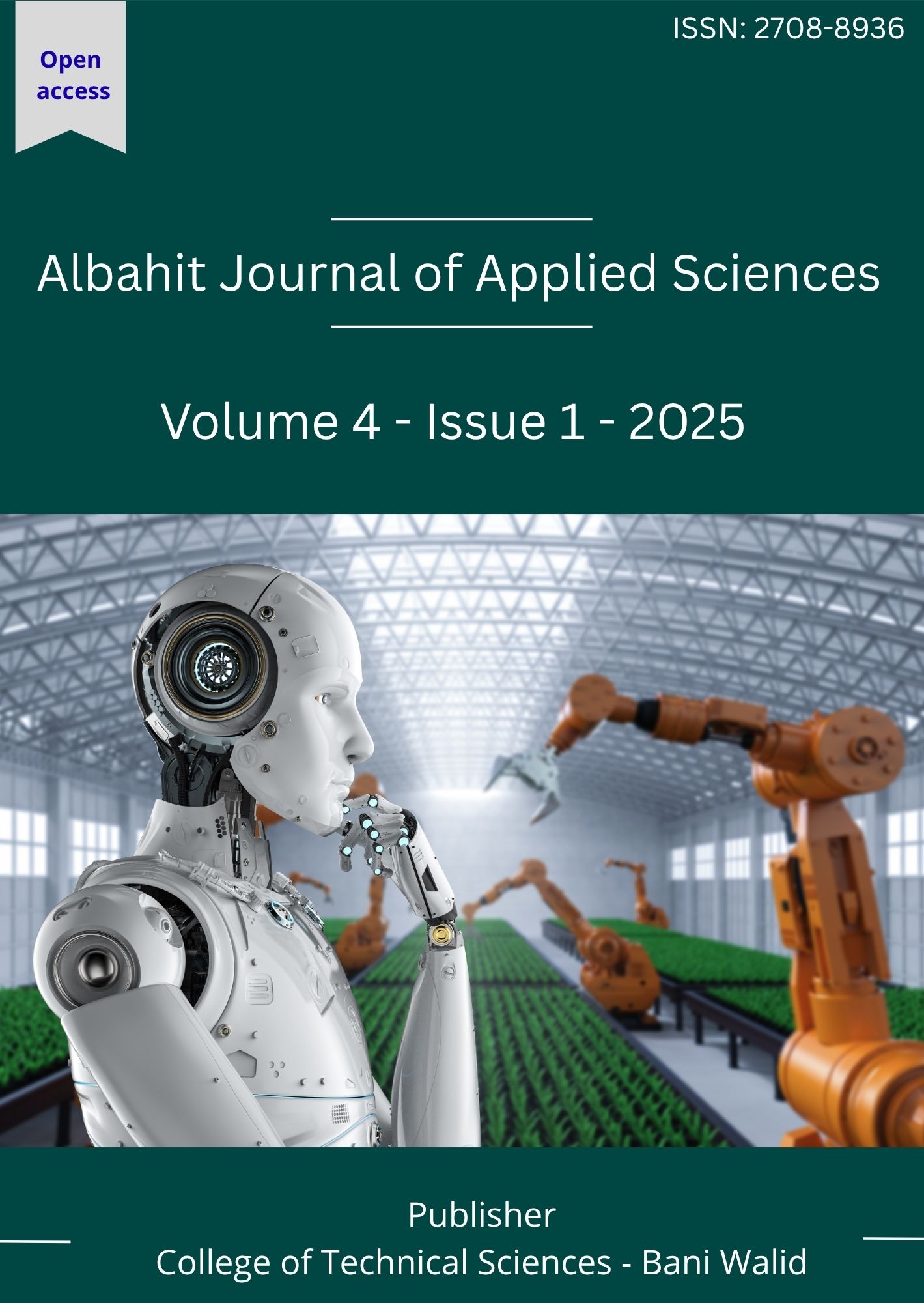The impact of mechanical workshop layout on risk reduction and improving operational efficiency
Keywords:
Mechanical planning, operational efficiency, occupational safety, workshop layoutAbstract
In this study, the purpose is to examine how mechanical workshop layout planning affects the workshop efficiency and occupational hazard reduction in automotive maintenance workshops. The study is a descriptive-analytical study that uses structured field observations and semi-structured interviews as the main data collection methods. Ten workshops on the road to the city of Zawiya were used as a sample.
The results of the research demonstrate a definite correlation between the quality of the work organization planning (distribution of working places, structure of movement or transportation ways, functional division of labor) and the promotion of the working conditions and work efficiency. Nevertheless, the analysis also reveals weaknesses in the practice of safety requirements, especially regarding emergency evacuation routes, and the availability of emergency equipment.
The research suggests the implementation of the functional oriented planning models using the principles of industrial engineering, and combining it with the operative safety systems. It also requires the integration of the continuous improvement practices and the periodic assessment of the internal workshop design. These results show that context-related design standards of mechanical workshops should be implemented, which will include the consideration of the operational efficiency alongside the safety of the workers
References
1. Ahmad, I., Rehan, M., Balkhyour, M. A., & Ismail, I. M. (2017). Assessment of occupational health and safety in motor vehicle repair workshops in Jeddah. Biosciences Biotechnology Research Asia, 14(3), 901–913.
2. Bi, S., Shao, L., Zheng, J., & Yang, R. (2024). Workshop layout optimization method based on sparrow search algorithm: A new approach. Journal of Industrial and Production Engineering. (Advance online publication).
3. Li, R., Chen, Y., Song, J., Li, M., & Yu, Y. (2023). Multi-objective optimization method of industrial workshop layout from the perspective of low carbon. Sustainability, 15(16), 12275.
4. López-Arquillos, A., & Rubio-Romero, J. C. (2016). Analysis of workplace accidents in automotive repair workshops in Spain. Safety and Health at Work, 7(3), 231–236.
5. Sing, L. S., Mahmood, S., Jiran, N. S., & Hassan, M. F. (2022). Ergonomics and improvement of workplace layout design in automotive service sector at motorcycle repair workshop
6. ACGIH. (n.d.). Industrial ventilation resources. https://www.acgih.org/ventilation/
7. Al-Ahmari, A., Abouda, A., & Al-Dualimi, S. (2017). Multi-objective layout planning for service workshops. Computers & Industrial Engineering, 112, 695–707. https://doi.org/10.1016/j.cie.2017.01.020
8. Gross, D., Shortle, J. F., Thompson, J. M., & Harris, C. M. (2008). Fundamentals of queueing theory (4th ed.). Wiley.
9. Hopp, W. J., & Spearman, M. L. (2011). Factory physics (3rd ed.). Waveland Press.
10. International Labour Organization (ILO). (2013). Safety and health in the use of machinery: ILO code of practice. https://www.ilo.org/sites/default/files/wcmsp5/groups/public/%40ed_protect/%40protrav/%40safework/documents/normativeinstrument/wcms_164653.pdf
11. International Organization for Standardization (ISO). (2010). ISO 12100:2010—Safety of machinery—General principles for design—Risk assessment and risk reduction. https://www.iso.org/standard/51528.html
12. International Organization for Standardization (ISO). (2015). ISO 13850:2015—Safety of machinery—Emergency stop function—Principles for design. https://www.iso.org/standard/59970.html
13. International Organization for Standardization (ISO). (2015). ISO 14120:2015—Safety of machinery—Guards—General requirements for design and construction. https://cdn.standards.iteh.ai/samples/59545/c1c055c111084169a27aa22bf360583c/ISO-14120-2015.pdf
14. International Organization for Standardization (ISO). (2018). ISO 45001:2018—Occupational health and safety management systems—Requirements with guidance for use. https://www.iso.org/standard/63787.html
15. International Organization for Standardization (ISO). (2019). ISO 13857:2019—Safety of machinery—Safety distances to prevent hazard zones being reached. https://cdn.standards.iteh.ai/samples/69569/0fd47bda23e343d18e259e1cc9670730/ISO-13857-2019.pdf
16. Little, J. D. C. (1961). A proof for the queueing formula L = λW. Operations Research, 9(3), 383–387.
17. Muchiri, P., & Pintelon, L. (2008). Performance measurement using overall equipment effectiveness (OEE): Literature review and practical application discussion. International Journal of Production Research, 46(13), 3517–3535.
18. Muther, R., & Hagenson, J. (2015). Systematic layout planning (4th ed.). Management & Industrial Research Publications.
19. National Fire Protection Association (NFPA). (2018). NFPA 33: Standard for spray application using flammable or combustible materials. https://www.nfpa.org/codes-and-standards/nfpa-33-standard-development/33
20. National Fire Protection Association (NFPA). (2024). NFPA 30: Flammable and combustible liquids code. https://www.nfpa.org/product/nfpa-30-flammable-and-combustible-liquids-code/p0030code
21. Niebel, B. W., & Freivalds, A. (2009). Methods, standards, and work design (12th ed.). McGraw-Hill.
22. Occupational Safety and Health Administration (OSHA). (n.d.). 29 CFR 1910.147—The control of hazardous energy (lockout/tagout). https://www.osha.gov/laws-regs/regulations/standardnumber/1910/1910.147
23. Occupational Safety and Health Administration (OSHA). (n.d.). 29 CFR 1910.212—General requirements for all machines. https://www.osha.gov/laws-regs/regulations/standardnumber/1910/1910.212
24. Prabowo, G. A., Cahyono, H., & Prasetyo, T. D. (2024). Analysis of workshop layout on the application of occupational health and safety. ResearchGate. https://www.researchgate.net/publication/384255183
25. Tompkins, J. A., White, J. A., Bozer, Y. A., & Tanchoco, J. M. A. (2010). Facilities planning (4th ed.). John Wiley & Sons.
26. Womack, J. P., & Jones, D. T. (2003). Lean thinking: Banish waste and create wealth in your corporation (2nd ed.). Free Press.
27. Zandin, K. B. (2001). MOST® work measurement systems. CRC Press.
28. Zakaria, S., Yamin, M. F. M., & Mohamed, A. A. (2022). Improving ergonomic conditions in motorcycle repair workshops. Journal of Design and Sustainable Environment, 2(1), 13–19. https://jdse.fazpublishing.com/index.php/jdse/article/view/31







